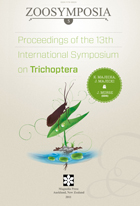Abstract
In 2006–2007 larval caddisfly assemblages of a semi-natural calcareous stream (Örvényesi Creek) were studied. Characteristic sections can be detected along the whole length of the stream, which passes through diverse types of vegetation, resulting in highly heterogeneous aquatic habitats. Based on an annual survey of different aquatic habitats, our aims were to give an overview of the spatio-temporal distribution of the larval caddisfly assemblages in the Örvényesi Creek and to find indicator species characterizing different sections of the stream. In order to show the spatio-temporal patterns, samples were collected at 7 locations with different streambed morphology, from spring to the mouth of the stream. Caddisfly larvae were collected in every 3rd week during a 1 year period using the “kick and sweep” method. Multivariate analyses were carried out to explore the spatio-temporal structure of caddisfly assemblages. The indicator value method was applied to detect indicator species for different sections of the stream. A rich caddisfly fauna (20 taxa) was found in the Örvényesi Creek. Fast-running and relatively cold-water hypocrenal sections were characterized by Beraea maurus and Apatania muliebris at high indicator value. Three Limnephilidae species (Limnephilus rhombicus, Limnephilus lunatus and Glyphotaelius pellucidus) were identified as significant indicator species for slow flowing, lentic habitats. Along the length of the stream, distinctive spatial and temporal changes were detected in the distribution of the caddisfly assemblages. These changes were mainly connected to variations in morphology of the streambed, phenology of individual taxa, extreme weather conditions and human impacts.

